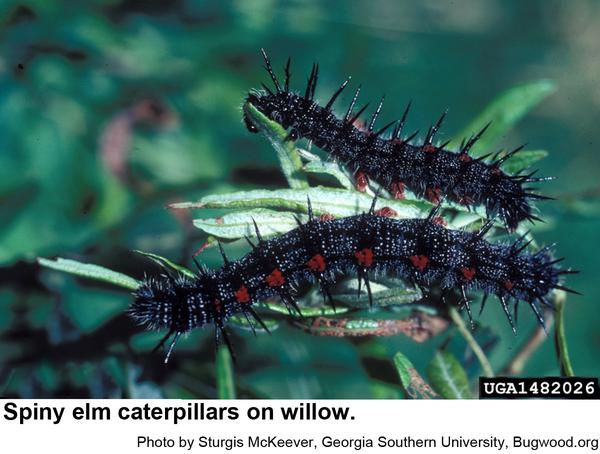Description and Biology
Spiny elm caterpillars, Nymphalis antiopa, the immatures of the mourning cloak butterfly, are relatively large, spiny caterpillars. Even though they have a common name, the caterpillars are rarely reported in North Carolina. These caterpillars usually feed in groups defoliating one branch before moving to the next. They feed for about 5 to 6 weeks and grow to 2 inches long. The velvety black body is covered with tiny white speckles. A row of eight conspicuous red spots runs down the back between conspicuous spines. Because the caterpillars are covered with spines, people often mistakenly assume that they sting (they don't). When the caterpillars have finished feeding, they scatter to hang from a branch and transform into a chrysalis from which an adult mourning cloak butterfly emerges about 3 weeks later. The chrysalis more or less resembles a mottled, brown, dead leaf. We have two broods each year from May to June and again in July and August. Mourning cloak butterflies overwinter in tree cavities, wood piles, hidden behind bark flaps, and in other protected sites. Some few overwinter as a chrysalides. During warm days in late winter mourning cloak butterflies sometimes emerge and fly. Shortly after the first new growth emerges on elms, females lay eggs in a ring around small twigs and branches. Mourning cloak butterflies are beautiful although somewhat somber. These butterflies have rich brown wings with yellow borders and rows of blue spots. The mourning cloak butterfly was named for the white or yellow band around the outside edge of the cloak worn during periods of mourning in medieval Germany and Scandinavia.
Host Plants
As the name implies, spiny elm caterpillars feed on the foliage of elm trees, but they also feed on willow, birch, cottonwood and hackberry.
Residential Recommendations
Because of our long growing season, our elm and other shade trees are normally tolerant of some defoliation, especially early in the season. Control efforts are unnecessary if only a few larval caterpillars are present. Established trees can tolerate the rare defoliation caused by these caterpillars. In the rare event of very high spiny elm caterpillar populations, it may feel necessary to control the worms. Most insecticides labeled for residential landscapes should give more than adequate control. Treat small caterpillars as soon as they are noticed for best results. Consider removing the caterpillars by handpicking or pruning if the tree is small enough to do so without having to use a ladder.
Other Resources
- Nymphalis antiopa (L.), Lepidoptera: Nymphalidae. Bush, B. 2016 (last modified). High Plains Integrated Pest Management. BugwoodWiki.
- Spiny Elm Caterpillar. Anonymous. 2020 (update). City of Winnipeg. Insect Control.
- Spiny Elm Caterpillar. Anonymous. 2016. Iowa State University, Horticulture and Home Pest News.
- Spiny elm caterpillar, Nymphalis antiopa. Hahn, J. 2020 (copyright). University of Minnesota Extension, Garden.
- NC State Extension Plant Pathology Publications
- NC State Extension Horticultural Science Publications
- North Carolina Agricultural Chemicals Manual
For assistance with a specific problem, contact your local Cooperative Extension center.
This factsheet has not been peer reviewed.
Publication date: July 9, 2020
Reviewed/Revised: May 7, 2025
Recommendations for the use of agricultural chemicals are included in this publication as a convenience to the reader. The use of brand names and any mention or listing of commercial products or services in this publication does not imply endorsement by NC State University or N.C. A&T State University nor discrimination against similar products or services not mentioned. Individuals who use agricultural chemicals are responsible for ensuring that the intended use complies with current regulations and conforms to the product label. Be sure to obtain current information about usage regulations and examine a current product label before applying any chemical. For assistance, contact your local N.C. Cooperative Extension county center.
N.C. Cooperative Extension prohibits discrimination and harassment regardless of age, color, disability, family and marital status, gender identity, national origin, political beliefs, race, religion, sex (including pregnancy), sexual orientation and veteran status.





